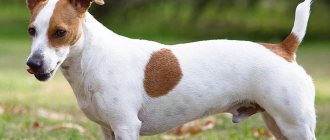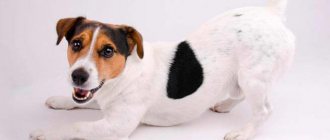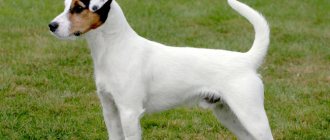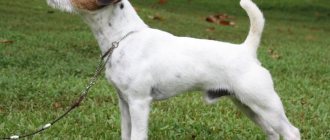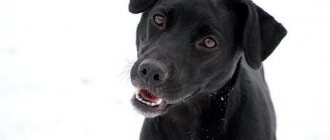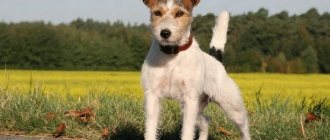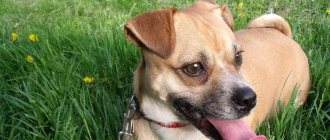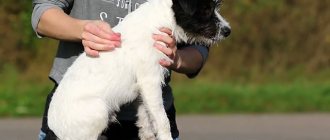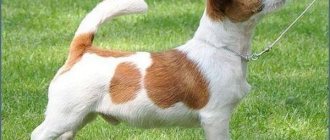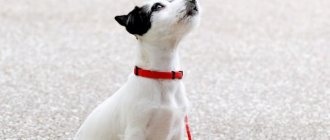Jack Russell Terriers are a breed of dog that was formed at the end of the 19th century and by now has become widespread throughout the world. The dogs, originally bred as hunting dogs, have become excellent companions for dog lovers. They are bred for their easy, friendly disposition, ease of training and easy care. They get along calmly in the apartment, love children, and put up with cats. Jack Russells are also doctors, travelers, actors, customs officers and simply cute, cheerful and active friends of man. Especially for you, we have collected all the most important and interesting features of this breed, based on the advice of dog handlers and experienced breeders.
Pros and cons of the breed
Jack Russell Terrier dogs have the following advantages:
- sociability;
- love for children;
- mobility;
- getting along with other pets;
- lack of aggression towards strangers;
- high intelligence;
- ability to adapt to changing environments;
- unpretentiousness;
- compact size.
But the owners also notice disadvantages:
- tendency to run away while walking;
- developed hunting instinct;
- cunning and ability to manipulate the owner;
- very high level of activity;
- tendency to defend one's territory;
- loud barking.
Most shortcomings can be smoothed out with training. The owners of a Jack Russell will have to devote a lot of time to raising it so that the puppy grows up smart and calm.
Allergenicity
Terriers do not pose a particular danger to allergy sufferers, especially since their hair is relatively short. The animal may grow a beard and eyebrows. You will have to carry out the trimming procedure and comb the dog in a timely manner. During trimming, those dead skin particles that cause an allergic reaction are also removed.
If you are prone to allergies, the optimal choice for a pet would be a Jack Russell Terrier with a “gesture” or “broken” coat. And if you are not afraid of shedding, then the smooth-haired Jack Russell Terrier is for you.
Breed characteristics
| Attitude towards children Excellent (rating 5/5) | Attitude towards strangers Good (rating 4/5) | Health Good (rating 4/5) |
| Picky eating Medium (rating 3/5) | Training Average (rating 3/5) | Shedding Strong (rating 5/5) |
| Need for care Low (rating 2/5) | Need for communication Very high (rating 5/5) | Friendliness High (rating 4/5) |
| Activity Very high (rating 5/5) | Intelligence High (rating 4/5) | Noise High (rating 4/5) |
| Security qualities Very developed (rating 4/5) | Maintenance cost Low (rating 2/5) | Price Average (rating 4/5) |
5. History of the Jack Russell Terrier breed
The history of the Jack Russell Terrier breed begins in the 20s of the 19th century, when priest John Russell began breeding a new breed of terriers. He was an avid hunter and wanted to breed the ideal partner for this activity - a dog with a strong character, high intelligence and a very good sense of smell. Distinctive qualities of the new terrier were also its small size, so that the dog could climb into holes for prey, and its white color, so that during a hunt it would not be shot at the dog instead of the game.
John Russell became interested in dog breeding at the age of 19, and already at the age of 23, in 1818, he acquired a female fox terrier and began breeding. He crossed it with other terriers, fighting dogs, bull terriers, and hunting breeds to get a dog with the ideal set of qualities. The breeder tried to instill in his dogs aggression towards game and friendliness towards people. Only 55 years later, in 1873, the priest registered a new breed, which he named Jack Russell in honor of his nickname and surname. The new terriers became the ideal embodiment of a hunting dog - they were small, hardy, loyal to their owner and amenable to training. They quickly gained popularity among British hunters and aristocrats, so John Russell founded a club for owners of this breed. It was this organization that slightly adjusted the breed standard, bringing it to perfection, and formalized the requirements for the appearance and character of Jack Russells.
Over the next 100 years, the Jack Russell evolved and spread. Gradually, breeders moved away from the breeding methods of their creator, who believed that dogs could be crossed not only with representatives of their own breed, but also with other terriers. This made it possible to maintain the purity of the blood and avoid blurring the main character traits. Over time, the standard of the Jack Russell also changed a little - the legs were shortened, the body shape became more streamlined. The dog, bred for hunting, was adapted for life in apartments and country houses as a pet and companion.
In 1975, the breed standard was officially approved, and breeders' clubs began to open throughout Europe. They were allowed to participate in exhibitions, and elite nurseries with breeding specimens appeared. Nowadays, Jack Russells are one of the most common breeds for apartment keeping, which are kept as companions in everyday life and hunting partners.
Appearance
The appearance of the Jack Russell is bright and memorable.
Brief description of appearance
This is a small, strong dog with well-developed muscles. Their physique provides them with great endurance and the ability to withstand prolonged physical activity.
The weight in the breed standard is not fixed, but normally ranges from 5 to 7 kilograms. These dogs have an intelligent, meaningful, penetrating look, making them seem like excellent partners and companions.
Dimensions
Jack Russells are small and compact. The sizes of females and males are almost the same and range from 25 to 30 centimeters at the withers. There are no standards for weight, but it is believed that for every 5 centimeters of height there should be 1 kilogram of weight for a harmonious physique. Thus, it should be between 5 and 7 kilograms. Excess weight is unacceptable - the dog will not only have health problems due to obesity, but also its physique will change.
Head
The Jack Russell's head is small, but quite large in relation to the body. In profile, the shape is triangular, noticeably elongated.
The skull is wide, slightly longer than the muzzle. The transition between the forehead and nose is pronounced, but harmonious.
Mouth
The mouth of representatives of this breed is large, with a large opening amplitude. The jaws are very powerful, which makes it possible to easily capture prey while hunting.
The teeth are strong and large relative to the size of the mouth. The lips are black or with pink splashes, and do not sag.
Eyes
The eyes of this breed are proportional in size to the muzzle. The shape is almond-shaped, the color is only brown, no other variants are found.
The gaze is clear, attentive, calm. The eyeballs are not set deeply, slightly covered by the eyelids.
Ears
The Jack Russell's ears are drooping and harmoniously match their muzzle in size. When straightened, they are very large. The tip is triangular, elongated. The ears are very mobile, they can rotate up to 180 degrees - this ensures good hearing.
Torso
The Jack Russell's body is strong, muscular, and has a streamlined body shape. The neck is strong and well defined.
The chest is not wide, the shoulder blades are tilted back. The back is narrow and straight. The paws are low and disproportionate to the body.
Paws
The front legs are straight, parallel to each other. The hind legs have more developed muscles than the front legs.
The bend of the knee is low, the lower part of the limb is set far back. The paw pads are dark and round. The fingers are pressed tightly together, the claws are sharp.
Wool
The coat can be rough, smooth or kinked. It sheds profusely during molting and requires careful care during this time. The shape of the hairs and their number should protect the dog well from cold and precipitation, so Jack Russells tolerate any weather conditions well.
Color
The predominant color of dogs of this breed is always white. This is necessary for this. So that the dog is clearly visible during the hunt and does not become an accidental victim of a shot. The spots are located on the face and back in random order.
Their color can range from black to sandy, but more often they are red or chestnut. There are also completely white terriers.
Possible disadvantages
The following appearance features are not included in the breed standard:
- the body is stretched in height, has the shape of a square;
- poorly developed jaw;
- small erect ears;
- pink spots on the nose;
- drooping tail in motion or improper docking;
- irregular shape of the front or hind legs;
- undeveloped muscles;
- sluggish movements, low intelligence;
- aggression, lack of friendliness and openness.
Appearance and standards
Representatives of the Jack Russell Terrier breed are small dogs. Height at the withers is about 30 cm, and weight is between 6-8 kg. This is a fairly strong and agile dog with strong bones and well-developed muscles.
The skull area between the ears should always be striped. The stop is well defined. The muzzle is elongated, the length from the nose to the stop should be slightly shorter than from the stop to the occipital protuberance. The lips fit tightly, the jaws are strong and wide, the teeth have a correct bite. The eyes are small. The nose, eyes, lips and eyelids are well pigmented. The ears are raised on cartilage or hanging, very mobile.
The physique is slightly elongated. The standard describes important proportions: the distance of the body from the withers to the chest should be equal to the length of the front leg from the ground to the elbow; girth behind the elbow joint is 40-43 cm. The top line should be straight. The chest is deep, but not wide. The tail can hang down, but always rises during movement. The legs are strong with well-developed muscles.
Jack Russell Terrier Coat Types
Jack Russell Terriers come in smooth and wire-haired varieties. Sometimes in the description of the breed you can find “long-haired Jack Russell Terrier”, which is what they call “stiff dogs”, which is not entirely correct. Smooth-haired dogs have very short hair, close to the body, and hard to the touch. Wirehaired Russells, in turn, are divided into two more types: brocken and rough. Broken hair has a single break, quite long, hard and rough, pressed tightly to the body. Raphs are distinguished by hard hair that does not fit tightly to the body, as a result the dog looks shaggy in places. The hair of the Rafiks is broken in several places.
The standard color allowed is white, two-color and three-color, with red or black spots on a predominantly white background. Red markings can range from dark chestnut to light shades.
Character
The main distinguishing feature of the Jack Russell Terrier's character is its tendency to be active and mobile. He cannot sit still, is constantly looking for something to do, runs around the apartment and tries to involve the owner in his games. If there are not enough toys in the room, the terrier will find them for himself, in the process of which he can significantly damage the furniture and encroach on the integrity of important and expensive things, documents, and wires. To avoid damage to property, you need to provide the dog with a sufficient number of toys, and during the absence of the owners, close the door to rooms where something important can be broken.
Jack Russell is perfectly adapted to apartment life due to its compact size and ability to adapt to any living conditions. But you need to walk with him at least once a day, preferably twice. You can even train a dog to go to the toilet in a diaper, but he will not be able to do without physical activity. This can deteriorate your character and cause health problems.
These are very smart dogs, so when playing with him you need to not only give him some objects, but also learn new commands, ask him to perform actions known to him. This will allow the terrier to spend time not only having fun, but also usefully, reinforcing basic behavioral skills.
Jack Russell is a very sociable breed. They cannot be alone for long and require attention from their owner. To achieve this, dogs can deliberately begin to play around, take away the necessary things, and bark loudly. In this case, it is useless to scold and punish him - it is better to just give the dog at least a few minutes of attention so that he feels needed.
Jack Russell very quickly becomes attached to his owners and loves all members of his family. He gets along with everyone - from kids to older people, and enjoys playing with them. This is one of the best breeds for families with children, since terriers are practically not prone to aggression, and due to their small size they will not be able to harm a child by accident. But before the dog appears in the house, children need to be instructed on the rules of behavior with animals and explained that they cannot be pulled, hit even during play, or held in arms by force.
Jack Russells rarely show aggression towards strangers. Most often it is expressed in loud barking, but if the dog is angered, it can cling to the enemy and leave noticeable damage on him. Jack Russells treat animals in their family calmly, especially if they do not attack first. But they are very aggressive towards other dogs of the same sex on the street and can even attack larger dogs.
Content Features
The temperament of a purebred dog has an important feature - it cannot stand loneliness. If he is given a place in an isolated space, the animal will suffer, which will affect the psyche and manifest itself in the form of cowardice. Getting used to sleeping with yourself or your children is also a bad idea. It is better to choose a place away from drafts, windows and not on the aisle, away from heating devices. Pros and cons of keeping dogs in an apartment:
- The advantage is the compact size of dogs of this breed, suitable for living in indoor conditions.
- The downside is the fact that if the owner cannot provide the pet with full motor activity on the street, then the dog will splash out its energy on interior items.
The option when the Jack Russell Terrier lives in a private house is much preferable. In good weather, your pet can be left to walk in the yard all day. With a large number of toys, he will have something to do. In the courtyard of a private house, you can make a small sports complex for your dog with your own hands, which will make his pastime more interesting and useful.
- How can a pensioner insure an apartment?
- Why is it important to find a hobby in retirement? 15 Hobby Ideas for Seniors
- A new method of treating COVID-19 using hyperbaric chambers
Education and training
Despite the small size of Jack Russells, training them is not as easy as it might seem. This is due to the fact that they have their own character, are smart and cunning, so they will only do those commands from which they can benefit. Raising a puppy should begin the moment he gets home. The first thing you need to do is accustom him to his nickname in order to establish contact with the pet, and designate places where he should not go. Hitting the dog is strictly prohibited: you should use a stern voice, but not shouting.
When interacting with a Jack Russell Terrier, you must immediately make it clear that the owner is a person, not him. You need to be firm and persistent, but not raise your voice. The dog must be rewarded for obedience, then he will have an incentive to behave as the owner wants. In this way, you can eliminate the main shortcomings of his behavior - loud barking, running away during walks, damage to property. The dog also needs to be given enough attention. The Jack Russell does most of his pranks to find a reason to spend time with his owner. If games and training are regular, and there is enough exercise at home, the terrier will not have to resort to extreme measures.
The puppy needs to be socialized as early as possible - spend time with him outside, introduce him to new people and animals. A dog that spends a lot of time at home will be more aggressive and nervous, so the terrier should interact with the outside world as often as possible.
At an older age, at 3-4 months, you can begin to learn basic commands. This will facilitate the interaction between a person and a dog and will help develop the Jack Russell's intelligence. He remembers commands easily and with pleasure, and in the future he will carry them out as part of the game. An untrained terrier will be bored without mental stress, be mischievous, and release his energy by damaging things.
Care and maintenance
Maintaining a Jack Russell does not require large material costs or waste of time.
Wool
Jack Russells are very susceptible to shedding, not only breeds with long hair, but also short-haired ones. They shed throughout the year, more than usual in spring and autumn. The coat needs to be combed every 2-3 days, but you can’t bathe it often - 3-4 times a year will be enough. If the dog gets dirty during a walk, its fur and paws should be wiped with a damp cloth or towel.
Eyes
Jack Russell eye care is standard. They need to be wiped regularly with a damp cotton swab to prevent mucus from accumulating in them. This should be done as discharge appears in the corners of the eyes.
Ears
Jack Russell's floppy ears require regular grooming. They need to be cleaned with cotton pads at least 2 times a week. Not only the inner, but also the outer part of the ear requires attention. Dirt can accumulate at the site of the fracture, which leads to infection. You also need to carefully monitor the dog’s behavior - if he begins to frequently scratch his ears with his paws or turn his head, you need to examine him and, if necessary, take him to the veterinarian.
Paws
Paws should be thoroughly wiped with a cloth after each walk, especially in wet weather. If this is not done, the dog will begin to clean himself, and dirt particles may get into his mouth. Nails should be trimmed one to three times a month depending on the dog's activity. The more often the dog walks, the faster they wear down on their own.
Ticks and fleas
Ticks pose a serious threat to health, so every time after a walk in the warm season, the dog should be carefully examined to detect parasites as quickly as possible. If they have already taken hold, it is better to take the dog to the veterinarian. There, the tick will be removed painlessly and in compliance with all sanitary rules, and a laboratory analysis will be carried out to determine whether it is a carrier of diseases.
Preventative flea treatment should be carried out every 3-4 months. To do this, a special antiparasitic agent is applied to the dog’s withers so that it cannot lick it off. For 3 days after the procedure, the terrier does not need to be petted or picked up frequently.
If fleas are already infested, the dog is bathed in anti-flea shampoo and smeared with the same product. Repeated treatment is carried out after a week, and the apartment is wet cleaned. The dog's bed is washed in hot water.
Smooth-haired
Smooth-haired Russells have relatively soft coats. It is smooth and fits tightly to the body. If such a dog lives in the yard, he sheds twice a year and lasts about a month.
With apartment maintenance, it lasts almost the entire year. Without proper care, this can clog up your apartment. To avoid this, such dogs need to be brushed daily with a brush with rubber teeth or a massage glove.
Trimming is not used for smooth-haired Russells - their hair is too short to be plucked by hand. Instead, a stripping procedure is carried out, that is, combing out using a furminator (a special dog comb in the form of a rake). It removes not only dead hair, but also undercoat. You should choose a model marked S (that is, small - for small breeds) and short hair (for short-haired ones). When kept at a yard, springing is necessary once every 2–3 months, when kept at home – 1–2 times a month.
We recommend this article:
Breed standard and characteristics of the Jack Russell Terrier
Diet
So that the dog is healthy and receives a sufficient amount of vitamins and microelements. You need to properly formulate his diet. It differs depending on age. Puppies are fed four times a day in small portions. Proteins should predominate in it, so you can cook meat and sea fish for small Jack Russells. You should also include eggs, cereals, raw and boiled vegetables in your diet.
After the puppy turns 4 months old, he is gradually transferred to a two-time diet. It is better to feed him half an hour after a walk, so that the dog wants to return home. A mature Jack Russell should be fed raw and boiled meat, fish, eggs, cereals, and dairy products. You need to focus on the dog’s taste preferences - if he doesn’t like a certain product, you shouldn’t force feed him.
It is better to feed the Jack Russell Terrier the following foods:
- boiled and raw chicken meat;
- sugar bones;
- fermented baked milk, kefir, cheese, cottage cheese;
- boiled eggs;
- sea fish without large bones;
- porridge;
- carrots, beets, apples as an addition to the main dish.
You need to refrain from:
- pork;
- river fish;
- tubular bones;
- salty, spicy, fried;
- Luke;
- mushrooms;
- chocolate.
Part of the diet can be replaced with premium and super premium dry food. It does not require cooking and contains most of the essential micronutrients, but does not provide the necessary dietary diversity. Therefore, it can be used as a replacement for the main food at a time when the owner does not have the opportunity to constantly prepare balanced natural meals.
Health and illness
The health of Jack Russells is quite good, but they are still susceptible to some diseases. Some of them are hereditary, and some can be avoided if you properly monitor your dog.
Hereditary diseases include the following problems.
- Hip dysplasia. It manifests itself in many purebred dogs and is expressed in lameness on the hind legs. It is impossible to completely cure the disease, but at an early stage, treatment can be prescribed that will relieve symptoms and improve the dog’s quality of life.
- Congenital deafness. All-white puppies are especially susceptible to this disease. Deafness is noticed at the age of 2-3 months, when the dog does not begin to respond to its name or respond to commands. It is impossible to cure it, but a canine specialist will help the special pet adapt to life in a family.
- Cataract. This is a disease that manifests itself as clouding of the lens and leads to complete blindness in one or both eyes. It is treated surgically: instead of the damaged lens, a prosthesis is installed, restoring the dog’s vision.
- Diabetes. It appears in adult dogs aged 8-9 years. The main symptoms are constant thirst, frequent urge to go to the toilet, lethargy and weakness. If diabetes is confirmed, the doctor prescribes insulin injections and a strict diet.
- Allergy. It manifests itself in the presence of discharge from the eyes and nose, itching on the skin. As treatment, antihistamines are given and the allergen is excluded from the diet.
The following diseases are considered acquired.
- Obesity. Excess weight not only spoils the appearance of the dog, but also leads to the appearance of many concomitant diseases. Terriers do not need to be overfed, and if obesity has already appeared, it is worth putting your pet on a diet.
- Cold. During the cold season, dogs may develop nasal discharge and cough. The disease cannot be neglected; treatment is prescribed by a doctor.
- Problems with the musculoskeletal system. Joints begin to ache in older dogs who either lack physical activity or, on the contrary, receive too much stress. The doctor prescribes symptomatic treatment and helps to adjust the dog’s activity regime.
To keep your dog healthy, you need to monitor his diet and take him for a preventive veterinary examination once a year in order to identify possible diseases in advance.
Health and congenital genetic diseases
In order to preserve the gene pool, breeders do not allow Jack Russell terriers to be crossed with other species. Due to the fact that this is an artificially bred breed, sometimes representatives have health problems associated with the accumulation of recessive genes. The result is the occurrence of hereditary pathologies. Regardless of good health, the animal is predisposed to certain diseases:
- Allergies are often caused by an increase in the body's immune response to various substances. Occurs due to the consumption of certain foods, the administration of medications or vaccines, insect bites, ingestion of plant pollen, etc.
- Luxation (displacement of the lens) - this pathology sometimes manifests itself between the ages of 3 and 8 years. The displacement can be observed in one or both eyes, it can be anterior or posterior. Moderate luxation is only possible as a result of eye injury.
- Cataracts are hereditary, but there is a risk of their development in older dogs or those with diabetes, exposed to radiation, high temperatures, or after injury.
- Congenital deafness occurs in predominantly white dogs. It is impossible to cure such a hereditary pathology. Here the representative of the breed is helped by a well-developed sense of smell, thanks to which he orients himself in space, even without hearing.
- Displacement of the kneecap - a tendency to this pathology occurs due to a genetic predisposition. The problem can arise and go away on its own, but in some cases it can lead to ligament rupture or arthritis.
- Legg-Calvé-Perthes syndrome (aseptic necrosis of the femoral head) causes lameness and joint pain. Pathology can make itself felt between the ages of 6 months and 1 year. Hip dysplasia is a flattening of the socket of the ligament, in which the head of the femur does not fully fit into the socket and it falls out. The disease is genetic and cannot be treated; only supportive therapy and reduction of the load on the deformed joint are possible.
Cases of Jack Russell Terrier disease with ataxia, myasthenia, and Von Willebrandt disease have been identified - all the result of genetic abnormalities. To avoid the risk of your pet developing serious incurable pathologies, when purchasing a puppy, the health report of the parents is checked. It is recommended to conclude an agreement with the breeder on reimbursement of costs for the treatment of hereditary diseases in the dog sold to him.
How long do Jack Russell terriers live?
The life expectancy of representatives of the breed ranges from 13 to 16 years. Proper care and care are the key to full development and good health. To prevent the occurrence of congenital anomalies, the puppy is periodically examined. To maintain the health of your four-legged friend, they monitor their diet throughout their life. An active pet is given the opportunity to splash out its vigorous energy. If all the conditions for keeping a Jack Russell are met, the animal will live a long and fulfilling life.
Interesting Facts
Jack Russells are cheerful dogs with an unusual breed history, so a lot of interesting things can be said about them.
- The Jack Russell Terrier breed comes from a dog named Trump. The name translated as “trump card”.
- These dogs are excellent actors and have starred in many films, including the famous TV series “Frasier”, the film “Mask”, and the comedy “My Dog Skip”.
- Jack Russells are afraid of the sun, so if you want to take them to the beach or on a summer hike, you should get a special sunscreen for dogs. Yes, they exist.
- Terriers are excellent psychotherapists. Jack Russell is used in canistherapy - a method of treatment with the help of dogs. They help with depression, anxiety, apathy, and nervousness.
- These dogs easily adapt to changes in environment, making them great for travelers. For example, Jack Russell Botie and her owners walked the entire Arctic and Antarctic in a small, warm overall and boots.
Care
Representatives of this breed are quite unpretentious in care. As mentioned above, Russells differ in the type of coat, and therefore the care of each type has its own characteristics.
Smooth-haired dogs are the easiest to care for, but they also shed more heavily than their wire-haired counterparts. The coat is brushed once a week with a coarse bristle brush. You can also use a special massage glove to improve blood circulation and relaxation. Wire-haired dogs need trimming - plucking out mature hair that does not fall out easily on its own. The procedure is quite labor-intensive and requires certain skills, so it is often entrusted to a specialist. It is recommended to carry out water procedures as needed, approximately once a month. Most of the Jack Russer Terrier's coat is white, but it always remains clean as it has the ability to self-clean.
It is also recommended to pay attention to dental health, especially if the dog eats natural food. It is necessary to provide it with special cleansing bones. You should also use a special paste and brush to clean your teeth, and this should be done at least 2 times a week. You should clean your ear several times a month. This can be done using special sanitary napkins and sticks.
How to choose a Jack Russell Terrier puppy
When all the conditions have been created for moving into a new friend’s apartment, the most important thing remains – to choose your puppy. You should only buy from trusted nurseries with a lot of positive reviews or from familiar breeders if you are confident in their reliability. Particular attention should be paid to the conditions in which small dogs are kept. If the enclosure is cramped and dirty, you should immediately abandon the option. Warning should also be caused by those owners who refuse to introduce the potential buyer to the entire litter and show only some of the puppies.
If you are satisfied with the nursery, you can begin choosing your future pet. First of all, you need to get to know his parents, evaluate their behavior and temperament. The puppies need to take a closer look. A healthy terrier will be active, friendly, and will actively make contact with people. Appearance also plays a role. The dog should be well-groomed, the coat should be smooth and uniform, the look should be clear and attentive. If an owner takes a dog to participate in exhibitions, it must be checked for compliance with the breed standard.
It is also worth taking a closer look at which puppy is most drawn to its future owner. He will be the most friendly, brave and open, just like a Jack Russell Terrier should be.
A little history
These hyperactive creatures were born thanks to the English pastor Jack Russell, who lives in Devonshire. The clergyman hunted on horseback and practiced breeding fox terriers. He was the first to describe this breed. Taking part in exhibitions, his conclusions about a particular breed were considered decisive.
Interesting to know! The modern breed is the short-legged Parson Jack Russell Terrier, which in the century before last was considered a fox terrier.
In developing a special breed of hunting dog, Jack Russell crossed Fox Terriers with other dog breeds. For example:
- With small bull terriers.
- With Lakeland Terriers.
- With border terriers.
After the death of the clergyman, breeding work did not stop, and the bred dogs began to be called Parson Jack Russell Terrier.
In the process of selection work, individuals appeared, both long-legged (up to 30 cm) and short-legged (up to 28 cm). The tall-legged individuals were very popular and were called Parson Russell Terriers. Short-legged individuals were somewhat inferior in their popularity and were few in number and little known, and were called Jack Russell terriers.
All about the breed - Jack Russell Terrier
How much does a puppy cost?
Jack Russell puppies cost from 10 to 50 thousand rubles, depending on the value of the breed.
- Dogs that do not have documents and have admixtures of other breeds in their blood cost 10-15 thousand. Their character may not correspond to the breed standard; they cannot participate in exhibitions.
- 15-25 thousand is the price of purebred terriers with documents. The breeder guarantees compliance with the standard. The dog is allowed to all exhibitions.
- 25-50 thousand is the price of elite individuals. Most often, they are purchased by breeders for subsequent reproduction and increasing the quality of the litter.
The Jack Russell Terrier is a cheerful and friendly breed of dog.
They are suitable for active, loving families with children who want to buy a puppy for their apartment, but will be willing to spend a lot of time with him outside. What do you think about Jack Russell Terriers?
Price
If you decide to buy a Russell, take this issue seriously. Do not purchase puppies from dubious persons; carefully study and check the documents. Visit exhibitions, watch and study the environment in which your future pet grows up.
Do not hesitate to ask the sellers all the points of interest; people interested in selling a puppy into good hands will be happy to meet you. Find nurseries, carefully read the reviews. There is a high probability of meeting scammers who will sell you an ordinary mongrel instead of a purebred puppy for a lot of money.
The price of Jack Russell terriers varies from 15 to 40 thousand rubles for a month-old puppy. Of course, it depends on the type of coat and pedigree. Don’t try to save money, choose according to external signs, carefully study the puppy.
